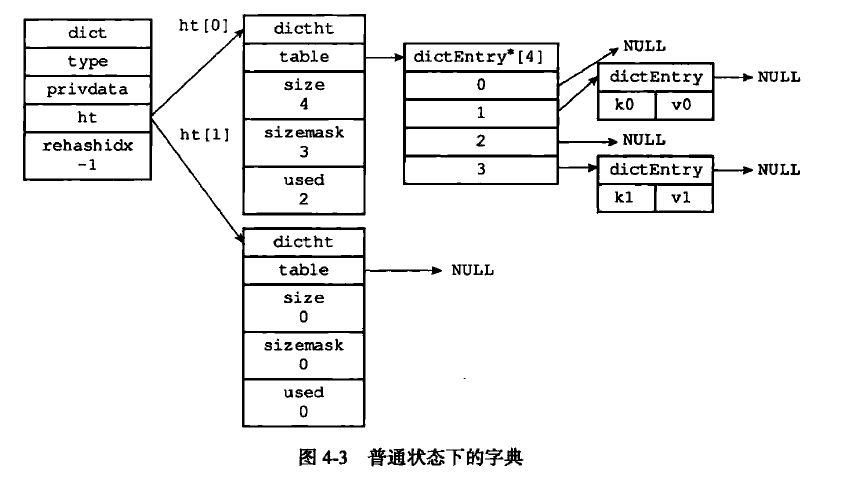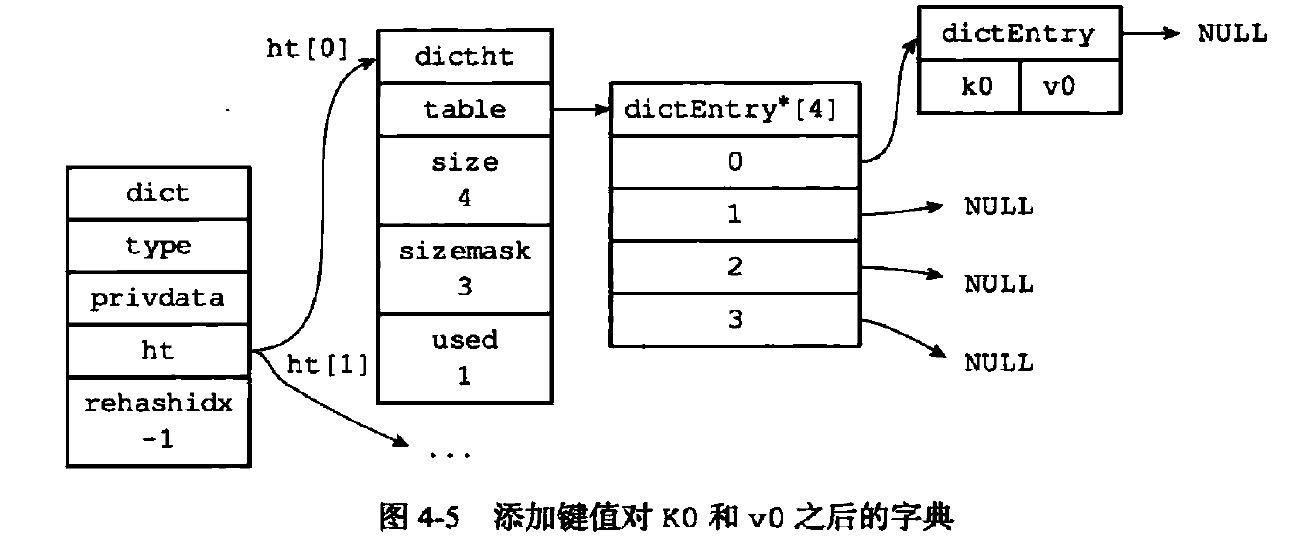字典是一种用于保存键值对(key value pair)的抽象数据结构。在字典中,一个键和一个值进行关联,就是所谓的键值对。字典中的每个键都是独一无二的,可以根据键查找、更新值,或者删除整个键值对等等。字典在Redis中的应用相当广泛,如Redis的数据库就是使用字典来作为底层实现的,对数据库的增、删、查、改操作也是构建在对字典的操作之上的。
Redis中,字典使用哈希表作为底层实现。有关字典和哈希表的结构体都定义在dict.h中,实现在dict.c中。
1:哈希表节点
哈希表节点使用dictEntry结构表示,dictEntry结构用来保存键值对。该结构体定义如下:
typedef struct dictEntry { void *key; union { void *val; uint64_t u64; int64_t s64; double d; } v; struct dictEntry *next; } dictEntry;
key保存键值对中的键,而v保存键值对中的值,值可以是一个指针,一个uint64_t整数,或者是一个int64_t整数。next是指向另一个哈希表节点的指针,利用该指针,可将多个哈希值相同的dictEntry连接在一起。
2:哈希表
Redis的字典使用哈希表作为底层实现,一个哈希表里面可以有多个节点,每个节点保存字典中的一个键值对。哈希表的结构体定义在dict.h中:
typedef struct dictht { dictEntry **table; unsigned long size; unsigned long sizemask; unsigned long used; } dictht;
table成员是一个指针数组,数组中的每个元素都是一个指向dictEntry结构的指针,size成员记录了哈希表的大小,也就是table数组的大小,used成员则记录了哈希表目前已有节点(键值对)的数量。sizemask成员的值总是等于size-1,该值和哈希值一起决定一个键应该被放到table数组的哪个索引上面。
3:字典
typedef struct dict { dictType *type; void *privdata; dictht ht[2]; long rehashidx; /* rehashing not in progress if rehashidx == -1 */ int iterators; /* number of iterators currently running */ } dict;
dictht是一个包含两个哈希表元素dictht的数组。一般情况下,字典只使用哈希表ht[0],而ht[1]只会在进行rehash时使用。另一个和rehash有关的属性就是rehashidx,它表示rehash目前的进度,如果目前没有在进行rehash,那么它的值为-1,rehash的介绍见下文。 type是一个指向dictType结构的指针,每个dictType结构保存了一组函数指针,这些函数用于操作特定类型的键值对,Redis会为用途不同的字典设置不同的类型特定函数。而privdata则保存了需要传给这些类型特定函数的可选参数。dictType结构定义如下:
typedef struct dictType { unsigned int (*hashFunction)(const void *key); void *(*keyDup)(void *privdata, const void *key); void *(*valDup)(void *privdata, const void *obj); int (*keyCompare)(void *privdata, const void *key1, const void *key2); void (*keyDestructor)(void *privdata, void *key); void (*valDestructor)(void *privdata, void *obj); } dictType;
下图就是一个普通状态下(没有进行rehash)的字典:

读者可以结合上图,理解前面说的dict,dictht,dictEntry三个数据结构
4:哈希算法
将一个新的键值对添加到字典中时,首先根据键计算出哈希值,然后根据哈希值计算出索引值,最后根据索引值,将包含新键值对的哈希表节点存储到哈希表数组中的指定索引上。
//使用哈希函数,计算key的哈希值 hash = dict->type->hashFunction(key); //使用哈希表的sizemask属性,根据哈希值计算出索引值 index = hash & dict->ht[x].sizemask;
比如,针对一个长度为4的哈希表来说,要将一个键值对k0和v0添加到字典中,先使用语句:hash = dict->type->hashFunction(k0); 计算出键k0的哈希值,假设得到的哈希值为8,则接着用:index = hash & dict->ht[0].sizemask;得到索引值(8 & 3 = 0)。最终,将包含键值对k0和v0的节点放置到哈希表数组的索引0上,如下图:

5:解决键冲突
当两个以上的键计算得到的哈希值一样时,称这些键发生了冲突。Redis的哈希表使用链接法来解决键冲突。通过哈希表节点dictEntry的next指针,将多个哈希表节点链接成一个单向链表。因dictEntry节点组成的链表没有指向链表表尾的指针,为了速度考虑,总是将新节点添加到链表的表头位置。如下图,就是用链接法解决k1和k2的冲突:

6:rehash
给定一个具有m个槽位,存储了n个元素的哈希表T,定义T的负载因子为n/m,也就是一个链表中的平均元素数目。随着操作的不断进行,哈希表保存的键值对会逐渐地增多或者减少,为了让哈希表的负载因子维持在一个合理的范围之内,当哈希表保存的键值对数量太多或太少时,需要对哈希表的大小进行相应的扩展或者收缩。这就是通过执行rehash操作来完成,rehash的步骤如下:
a:为字典的哈希表ht[1]分配空间,分配的空间大小取决于要执行的操作,以及ht[0].used 的值:
如果执行的是扩展操作,那么ht[1]的大小为第一个大于等于2*(ht[0].used)的2^n(2的n次幂);
如果执行的是收缩操作,那么ht[1]的大小为第一个大于等于ht[0].used的2^n(2的n次幂);
b:重新计算ht[0]中每个键的哈希值和索引值,然后将键值对放置到ht[1]哈希表的指定位置上。
c:当ht[0]上所有键值对都迁移到ht[1]之后,释放ht[0],将ht[1]设置为ht[0],并在ht[1]新创建一个空白哈希表,为下一次rehash做准备。
举个例子,当需要对字典收缩空间时,收缩空间的函数是dictResize,分配空间的函数为dictExpand,它们的实现如下:
int dictResize(dict *d) { int minimal; if (!dict_can_resize || dictIsRehashing(d)) return DICT_ERR; minimal = d->ht[0].used; if (minimal < DICT_HT_INITIAL_SIZE) minimal = DICT_HT_INITIAL_SIZE; return dictExpand(d, minimal); } int dictExpand(dict *d, unsigned long size) { dictht n; /* the new hash table */ unsigned long realsize = _dictNextPower(size); /* the size is invalid if it is smaller than the number of * elements already inside the hash table */ if (dictIsRehashing(d) || d->ht[0].used > size) return DICT_ERR; /* Rehashing to the same table size is not useful. */ if (realsize == d->ht[0].size) return DICT_ERR; /* Allocate the new hash table and initialize all pointers to NULL */ n.size = realsize; n.sizemask = realsize-1; n.table = zcalloc(realsize*sizeof(dictEntry*)); n.used = 0; /* Is this the first initialization? If so it's not really a rehashing * we just set the first hash table so that it can accept keys. */ if (d->ht[0].table == NULL) { d->ht[0] = n; return DICT_OK; } /* Prepare a second hash table for incremental rehashing */ d->ht[1] = n; d->rehashidx = 0; return DICT_OK; }
static unsigned long _dictNextPower(unsigned long size)
{
unsigned long i = DICT_HT_INITIAL_SIZE;
if (size >= LONG_MAX) return LONG_MAX;
while(1) {
if (i >= size)
return i;
i *= 2;
}
}
上面的三个函数说明了缩小字典空间时,计算新哈希表大小的步骤。
dictExpand函数的参数size为分配空间的基准值,实际要分配空间的大小realsize为大于等于size的2的n次幂,但是realsize最小为DICT_HT_INITIAL_SIZE(4)。比如size为1,2,3或4,则realsize为4;size为17,则realsize为32。
dictRehash的函数实现如下:
int dictRehash(dict *d, int n) { int empty_visits = n*10; /* Max number of empty buckets to visit. */ if (!dictIsRehashing(d)) return 0; while(n-- && d->ht[0].used != 0) { dictEntry *de, *nextde; /* Note that rehashidx can't overflow as we are sure there are more * elements because ht[0].used != 0 */ assert(d->ht[0].size > (unsigned long)d->rehashidx); while(d->ht[0].table[d->rehashidx] == NULL) { d->rehashidx++; if (--empty_visits == 0) return 1; } de = d->ht[0].table[d->rehashidx]; /* Move all the keys in this bucket from the old to the new hash HT */ while(de) { unsigned int h; nextde = de->next; /* Get the index in the new hash table */ h = dictHashKey(d, de->key) & d->ht[1].sizemask; de->next = d->ht[1].table[h]; d->ht[1].table[h] = de; d->ht[0].used--; d->ht[1].used++; de = nextde; } d->ht[0].table[d->rehashidx] = NULL; d->rehashidx++; } /* Check if we already rehashed the whole table... */ if (d->ht[0].used == 0) { zfree(d->ht[0].table); d->ht[0] = d->ht[1]; _dictReset(&d->ht[1]); d->rehashidx = -1; return 0; } /* More to rehash... */ return 1; }
参数n表示要进行rehash的步数(要进行rehash的buckets数量)。如果所有bucket都是有内容的(链表非空),则该函数会进行n个bucket的rehash操作。但可能有些bucket是空的(空链表),所以,该函数总共会跳过10*n个空bucket。因此,在遇到一个真正有内容的bucket之前,如果存在10*n个以上的空bucket,该函数只是跳过10*n个空bucket,直接返回1,而不进行任何rehash操作。
d->rehashidx表示在d->ht[0]哈希表中要进行rehash操作的bucket的索引。在dictExpand中它被置为0,表示从d->ht[0].table[0]开始进行rehash操作。每次rehash操作之前,都要保证rehashidx的值小于d->ht[0].size。
找到要进行rehash操作的ht[0]中的bucket之后,遍历该bucket中的链表,对其中的每个节点进行rehash,首先计算该节点在d->ht[1].table中所在bucket的索引,然后插入到ht[1]的该bucket中的链表中。
遍历完ht[0]中的该bucket的链表后,将该bucket置空,并且rehashidx++,开始进行下一步rehash。
遍历完n个bucket之后,会判断d->ht[0]中的节点是否都已经rehash完成,如果已全部完成,则释放d->ht[0].table,将ht[1]置为ht[0],并初始化新的ht[1],置rehashidx为-1,最后返回0,表示rehash已完成。如果ht[0]中尚有节点未进行rehash,则直接返回1。
8:渐进式rehash
如果哈希表里保存的键值对数量非常多时,要一次性的将所有键值对全部rehash到ht[1]的话,庞大的计算量可能会导致服务器在一段时间内停止服务。为了避免rehash对服务器性能造成影响,服务器不是一次性将ht[0]里面的所有键值对全部rehash到ht[1],而是分多次、渐进式地将ht[0]里面的键值对慢慢地rehash到ht[1],以下是哈希表渐进式rehash的详细步骤:
a:为ht[1]分配空间,让字典同时持有ht[0]和ht[1]两个哈希表。
b:在字典中维持一个索引计数器变量rehashidx,并将它的值设置为0,表示rehash正式开始。
c:在rehash进行期间,每次对字典执行添加、删除、查找或者更新操作时,除了执行指定的操作以外,还会顺带将ht[0]在rehashidx索引上的所有键值对rehash到ht[1]上,当rehash工作完成之后,rehashidx++。
d:随着字典操作的不断执行,最终在某个时间点上,ht [0]的所有键值对都会被rehash至ht[1],这时程序将rehashidx属性的值设为-1,表示rehash操作已完成。
下面是在rehash时,查找过程的实现
dictEntry *dictFind(dict *d, const void *key) { dictEntry *he; unsigned int h, idx, table; if (d->ht[0].size == 0) return NULL; /* We don't have a table at all */ if (dictIsRehashing(d)) _dictRehashStep(d); h = dictHashKey(d, key); for (table = 0; table <= 1; table++) { idx = h & d->ht[table].sizemask; he = d->ht[table].table[idx]; while(he) { if (dictCompareKeys(d, key, he->key)) return he; he = he->next; } if (!dictIsRehashing(d)) return NULL; } return NULL; }
该函数中,如果字典当前正在rehash,则首先调用_dictRehashStep进行1步rehash操作。
然后调用dictHashKey得到该key的哈希值;先得到该哈希值在ht[0]中对应的索引值,得到索引值之后,就在哈希表ht[0]相应的bucket中,对比链表中的每个节点,寻找该key,如果找到,则直接返回对应的dictEntry。
如果没找到,且字典当前正在rehash,则接着在ht[1]中继续寻找过程,否则,直接返回NULL。
如果处于rehash中,则字典的其他操作,如增加、更新和删除都会进行_dictRehashStep操作,需要注意的是增加操作,新的键值对一律被保存到ht[1]上,而ht[0]不再进行任何添加操作,保证了ht[0]包含的键值对数量会只减不增,并随着rehash操作的执行而最终变成空表。